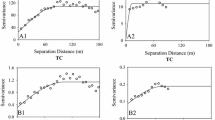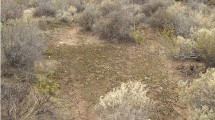Abstract
Background and aims
Plant-soil interactions are a crucial component of ecosystem functioning. However, most global change studies focus on plant communities, with information on soil properties and performance being scarce. Our goal was to assess the individual and joint effect of habitat heterogeneity and three global change drivers (fragmentation, loss of habitat quality and climate change) on nutrient availability and soil microbial activity in Mediterranean gypsum soils.
Methods
We collected soil samples from an experimental field site from large/small fragments, with high/low habitat quality, subjected to two levels of water availability (dry/mesic) and from two microhabitats (under the canopy of shrubs and in the open). We analyzed nutrient concentrations (C, N and P) and enzymatic activities (ß-glucosidase, urease and acid phosphatase).
Results
C, N, P content, ß-glucosidase, urease and acid phosphatase activities were higher under the canopy than in the open and in high- than in poor- habitat quality sites. These differences were exacerbated in small fragments.
Conclusions
The strong interdependence between plant and soil was modulated by fragmentation in the Mediterranean gypsum soils studied. Drought did not exert a direct negative effect on soil properties, although the effect might arise under more intense drought or under drought taking place at times of the year different from those explored here. Results highlight the importance of considering several drivers simultaneously to forecast realistic ecosystem responses to global change.




Similar content being viewed by others
References
Aguilar R, Ashworth L, Galetto L, Aizen MA (2006) Plant reproductive susceptibility to habitat fragmentation: review and synthesis through a meta-analysis. Eco Lett 9:968–980
Allen AS, Schlesinger WH (2004) Nutrient limitations to soil microbial biomass and activity in loblolly pine forests. Soil Biol Biochem 36(4):581–589
Boutin C, Jobin B (1998) Intensity of agricultural practices and effects on adjacent habitats. Ecol Appl 8(2):544–557
Brook BW, Sodhi NS, Bradshaw CJA (2008) Synergies among extinction drivers under global change. Trends Ecol Evol 23(8):453–460
Casals P, Gimeno C, Carrara A, Lopez-Sangil L, Sanz MJ (2009) Soil CO2 efflux and extractable organic carbon fractions under simulated precipitation events in a Mediterranean Dehesa. Soil Biol Biochem 41(9):1915–1922
Christensen JH (2007) Regional climate projections. Contribution of Working Group I to the Fourth Assessment Report of the Intergovernmental Panel on Climate Change. Climate Change 2007: the physical science basis. Cambridge University Press, New York
Cookson WR, Osman M, Marschner P, Abaye DA, Clark I, Murphy DV, Stockdale EA, Watson CA (2007) Controls on soil nitrogen cycling and microbial community composition across land use and incubation temperature. Soil Biol Biochem 39(3):744–756
Day KJ, Hutchings MJ, John EA (2003) The effects of spatial pattern of nutrient supply on yield, structure and mortality in plant populations. J Ecol 91:541–553
Eivazi F, Zakaria A (1993) Beta-glucosidase activity in soils amended with sewage-sludge. Agric Ecosyst Environ 43(2):155–161
Ellstrand NC, Elam DR (1993) Population genetic consequences of small population-size–implications for plant conservation. Annu Rev Ecol Syst 24:217–242
Fenner MHaM (2001) Growth of aleppo pine (Pinus halepensis) deprived of single mineral nutrients. J Med Ecol (2):107–112
Fischer M, Hock M, Paschke M (2003) Low genetic variation reduces cross-compatibility and offspring fitness in populations of a narrow endemic plant with a self-incompatibility system. Conserv Genet 4(3):325–336
Foley JA, DeFries R, Asner GP, Barford C, Bonan G, Carpenter SR, Chapin FS, Coe MT, Daily GC, Gibbs HK, Helkowski JH, Holloway T, Howard EA, Kucharik CJ, Monfreda C, Patz JA, Prentice IC, Ramankutty N, Snyder PK (2005) Global consequences of land use. Science 309(5734):570–574
Gallardo A, Schlesinger WH (1994) Factors limiting microbial biomass in the mineral soil and forest floor of a warm-temperate forest. Soil Biol Biochem 26(10):1409–1415
Garcia C, Hernandez T, Roldan A, Martin A (2002) Effect of plant cover decline on chemical and microbiological parameters under Mediterranean climate. Soil Biol Biochem 34(5):635–642
Garcia-Palacios P, Maestre FT, Gallardo A (2011) Soil nutrient heterogeneity modulates ecosystem responses to changes in the identity and richness of plant functional groups. J Ecol 99(2):551–562
Goberna M, Pascual JA, Garcia C, Sanchez J (2007) Do plant clumps constitute microbial hotspots in semiarid Mediterranean patchy landscapes? Soil Biol Biochem 39(5):1047–1054
Harrison S, Bruna E (1999) Habitat fragmentation and large-scale conservation: what do we know for sure? Ecography 22(3):225–232
Henkin Z, Seligman NG, Kafkafi U, Noy-Meir I (1998) ‘Effective growing days’: a simple predictive model of the response of herbaceous plant growth in a Mediterranean ecosystem to variation in rainfall and phosphorus availability. J Ecol 86(1):137–148
Hodge A, Stewart J, Robinson D et al (2000) Competition between roots and soil micro-organisms for nutrients from nitrogen-rich patches of varying complexity. J Ecol 88:150–164
Jensen KD, Beier C, Michelsen A, Emmett BA (2003) Effects of experimental drought on microbial processes in two temperate heathlands at contrasting water conditions. Appl Soil Ecol 24(2):165–176
Kardol P, Wardle DA (2010) How understanding aboveground-belowground linkages can assist restoration ecology. Trends Ecol Evol 25(11):670–679
Kramer S, Green DM (2000) Acid and alkaline phosphatase dynamics and their relationship to soil microclimate in a semiarid woodland. Soil Biol Biochem 32(2):179–188
Kruger FJ (1979) South African Heathlands. Ecosystems of the world. Heathlands and related schrubland. Elselvier, Amsterdam
Lambers H, Chapin FS, Pons TL (1998) Plant physiological ecology. New York, USA
Larcher W (2000) Temperature stress and survival ability of Mediterranean sclerophyllous plants. Plant Biosys 134(3):279–295
Lavorel S, Canadell J, Rambal S, Terradas J (1998) Mediterranean terrestrial ecosystems: research priorities on global change effects. Global Ecol Biogeogr 7(3):157–166
Li XZ, Sarah P (2003) Enzyme activities along a climatic transect in the Judean Desert. Catena 53(4):349–363
Lienert J (2004) Habitat fragmentation effects on fitness of plant population: a review. J Nat Conserv 12:53–72
Maestre FT, Cortina J (2002) Spatial patterns of surface soil properties and vegetation in a Mediterranean semi-arid steppe. Plant Soil 241(2):279–291
Maestre FT, Reynolds JF (2006) Spatial heterogeneity in soil nutrient supply modulates nutrient and biomass responses to multiple global change drivers in model grassland communities. Global Change Biol 12(12):2431–2441
Martinez I, Escudero A, Maestre FT, de la Cruz A, Guerrero C, Rubio A (2006) Small-scale patterns of abundance of mosses and lichens forming biological soil crusts in two semi-arid gypsum environments. Aust J Bot 54(4):339–348
Matesanz S, Escudero A, Valladares F (2009) Impact of three global change drivers on a Mediterranean shrub. Ecology 90(9):2609–2621
Matias L, Castro J, Zamora R (2010) Soil-nutrient availability under a global-change scenario in a mediterranean mountain ecosystem. Global Change Biol 17(4):1646–1657
Michelsen A, Graglia E, Schmidt IK, Jonasson S, Sleep D, Quarmby C (1999) Differential responses of grass and a dwarf shrub to long-term changes in soil microbial biomass C, N and P following factorial addition of NPK fertilizer, fungicide and labile carbon to a heath. New Phytol 143(3):523–538
Moreno JL, Garcia C, Hernandez T (2003) Toxic effect of cadmium and nickel on soil enzymes and the influence of adding sewage sludge. Eur J Soil Sci 54(2):377–386
Nannipieri P, Ceccanti B, Cervelli S, Matarese E (1980) Extraction of phosphatase, urease, proteases, organic-carbon, and nitrogen from soil. Soil Sci Soc A J 44(5):1011–1016
Noy-Meir I (1973) Desert ecosystems, environment and producers. Annu Rev Ecol Syst (4):25–41
Panikov NS (1999) Understanding and prediction of soil microbial community dynamics under global change. Appl Soil Ecol 11(2–3):161–176
Parkinson D, Coleman DC (1991) Methods for assesing soil microbial populations, activity and biomass. Agric Ecos Env 34:3–33
Pias B, Matesanz S, Herrero A, Gimeno TE, Escudero A, Valladares F (2010) Transgenerational effects of three global change drivers on an endemic Mediterranean plant. Oikos 119(9):1435–1444
Radojevic M, Bashkin VN (1999) Practical environmental analysis. The Royal Society of Chemistry, Cambridge
Rantalainen ML, Fritze H, Haimi J, Pennanen T, Seta H (2005) Species richness and food web structure of soil decomposer community as affected by the size of habitat fragment and habitat corridors. Global Change Biol 11:1614–1627
Rantalainen ML, Haimi J, Fritze H, Pennanen T, Seta H (2008) Soil decomposer community as a model system in studying the effects of habitat fragmentation and habitat corridors. Soil Biol Biochem 40:853–863
Reich PB, Knops J, Tilman D et al (2001) Plant diversity enhances ecosystem responses to elevated CO2 and nitrogen deposition. Nature 410:809–812
Reynolds JF, Kemp PR, Ogle K, Fernandez RJ (2004) Modifying the ‘pulse-reserve’ paradigm for deserts of North America: precipitation pulses, soil water, and plant responses. Oecologia 141(2):194–210
Reynolds JF, Stafford-Smith MD, Lambin EF, Turner B II, Mortimore M, Batterbury SPJ et al (2007) Global desertification: building a science for dryland development. Science 316:847–851
Sala OE, Chapin FS, Armesto JJ, Berlow E, Bloomfield J, Dirzo R, Huber-Sanwald E, Huenneke LF, Jackson RB, Kinzig A, Leemans R, Lodge DM, Mooney HA, Oesterheld M, Poff NL, Sykes MT, Walker BH, Walker M, Wall DH (2000) Biodiversity–global biodiversity scenarios for the year 2100. Science 287(5459):1770–1774
Sardans J, Penuelas J (2004) Increasing drought decreases phosphorus availability in an evergreen Mediterranean forest. Plant Soil 267(1–2):367–377
Sardans J, Penuelas J (2005) Drought decreases soil enzyme activity in a Mediterranean Quercus ilex L. forest. Soil Biol Biochem 37(3):455–461
Sardans J, Penuelas J (2007) Drought changes phosphorus and potassium accumulation patterns in an evergreen Mediterranean forest. Funct Ecol 21(2):191–201
Schlesinger WH, Pilmanis AM (1998) Plant-soil interactions in deserts. Biogeochemistry 42(1–2):169–187
Schleuning M, Niggemann M, Becker U, Matthies D (2008) Negative effects of habitat degradation and fragmentation on the declining grassland plant Trifolium montanum. Basic Appl Ecol 10(1):61–69
Stephan A, Meyer AH, Schmid B (2000) Plant diversity affects culturable soil bacteria in experimental grassland communities. J Ecol 88(6):988–998
Tabatabai MA (1982) Soil enzymes. In: Page AL, Millar EM, Keeney DR (eds) Methods of soil analysis. ASA and SSSA, Madison, pp 501–538
Tilman D, Reich PB, Knops J, Wedin D, Mielke T, Lehman C (2001) Diversity and productivity in a long-term grassland experiment. Science 294(5543):843–845
Valladares F, Camarero JJ, Pulido F, Gil-Pelegrín E (2008) El bosque mediterráneo, unsistema humanizado y dinámico. In: Valladares F (ed) Ecología del bosque mediterráneo en un mundo cambiante, 2nd edn. Madrid, pp15–28
van der Putten WH, Bardgett RD, de Ruiter PC, Hol WHG, Meyer KM, Bezemer TM, Bradford MA, Christensen S, Eppinga MB, Fukami T, Hemerik L, Molofsky J, Schadler M, Scherber C, Strauss SY, Vos M, Wardle DA (2009) Empirical and theoretical challenges in aboveground-belowground ecology. Oecologia 161(1):1–14
Wacker L, Baudois O, Eichenberger-Glinz S, Schmid B (2008) Environmental heterogeneity increases complementarity in experimental grassland communities. Basic Appl Ecol 9(5):467–474
Wainwright J (1996) Infiltration, runoff and erosion characteristics of agricultural land in extreme storm events, SE France. Catena 26(1–2):27–47
Walkley A, Black IA (1934) An examination of the Degtjareff method for determining soil organic matter, and a proposed modification of the chromic acid titration method. Soil Sci 37(1):29–38
Yeomans J, Bremmer JM (1989) A rapid and precise method four routine determination of organic carbon in soil. Commun Soil Sci Plant Anal 19:1467–1476
Zak DR, Tilman D, Parmenter RR, Rice CW, Fisher FM, Vose J, Milchunas D, Martin CW (1994) Plant-production and soil-microorganisms in late-successional ecosystems—a continental-scale study. Ecology 75(8):2333–2347
Zak DR, Holmes WE, White DC, Peacock AD, Tilman D (2003) Plant diversity, soil microbial communities, and ecosystem function: are there any links? Ecology 84(8):2042–2050
Zavaleta ES, Shaw MR, Chiariello NR, Mooney HA, Field CB (2003) Additive effects of simulated climate changes, elevated CO2, and nitrogen deposition on grassland diversity. Proc Natl Acad Sci U S A 100(13):7650–7654
Acknowledgements
Thanks are due to Fernando Maestre for help and wise advice on soil and microbial analyses. Funding was provided by the Spanish Ministry for Innovation and Science with the grants Consolider Montes (CSD2008_00040) and VULGLO (CGL2010-22180-C03-03), and by the Community of Madrid grant REMEDINAL 2 (CM S2009/AMB-1783).
We thank MNCN colleagues for field assistance and support and Y. Valiñani and B. Cuartero for their valuable help and advice with chemical analysis.
Author information
Authors and Affiliations
Corresponding author
Additional information
Responsible Editor: Jeff R. Powell.
Rights and permissions
About this article
Cite this article
Lázaro-Nogal, A., Matesanz, S., Gimeno, T.E. et al. Fragmentation modulates the strong impact of habitat quality and plant cover on fertility and microbial activity of semiarid gypsum soils. Plant Soil 358, 213–223 (2012). https://doi.org/10.1007/s11104-012-1184-9
Received:
Accepted:
Published:
Issue Date:
DOI: https://doi.org/10.1007/s11104-012-1184-9




